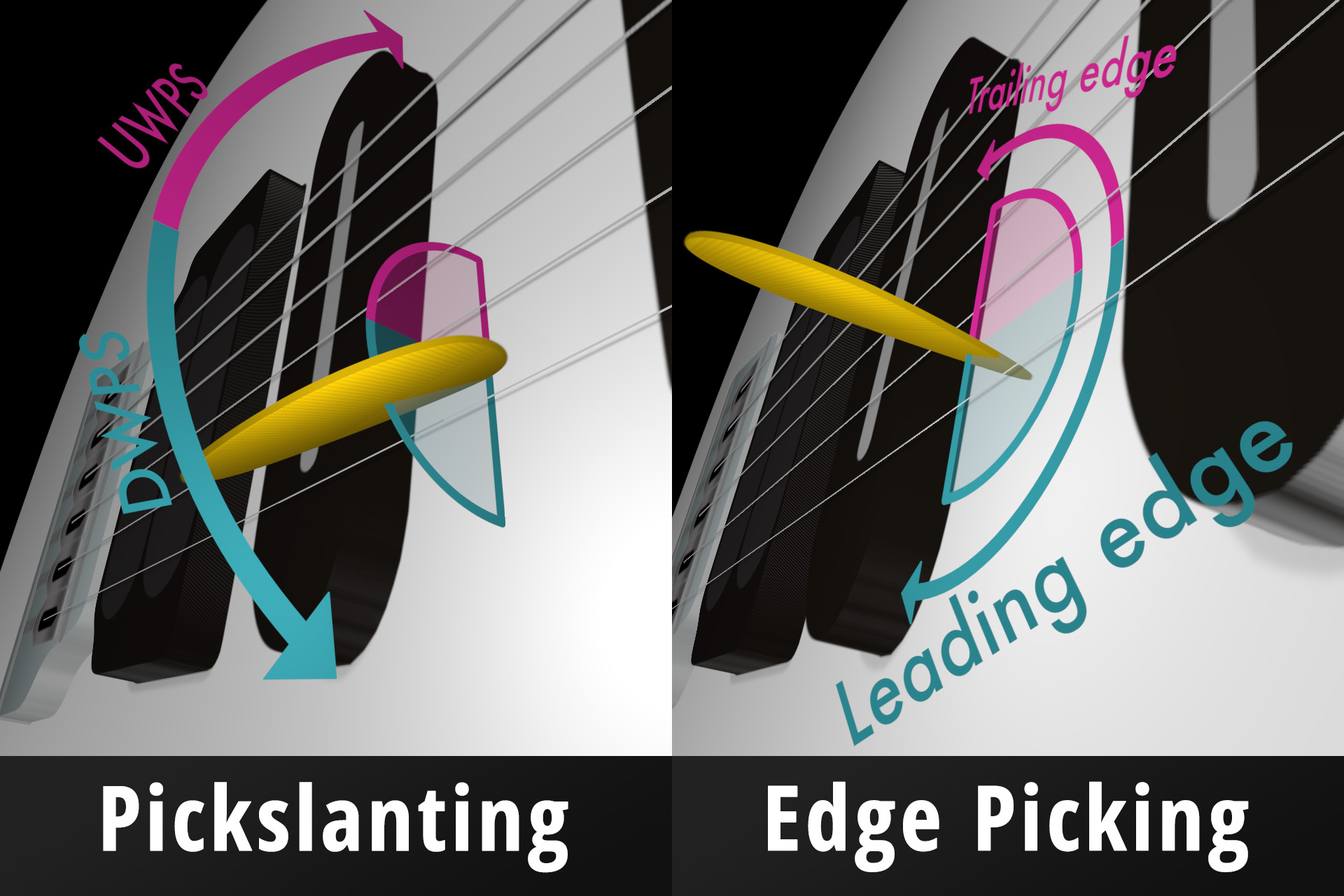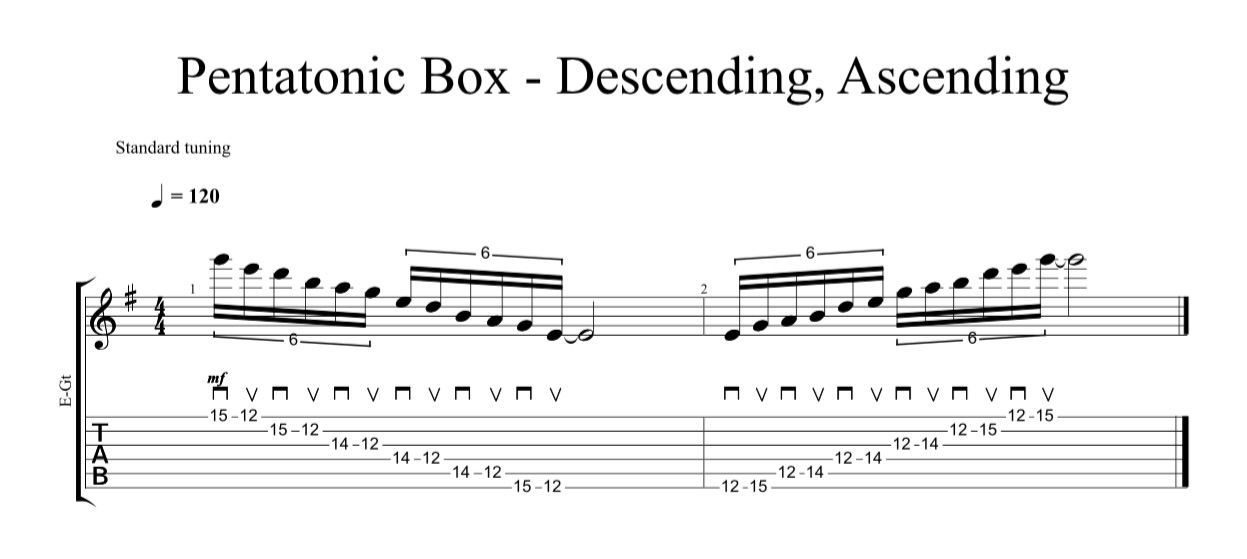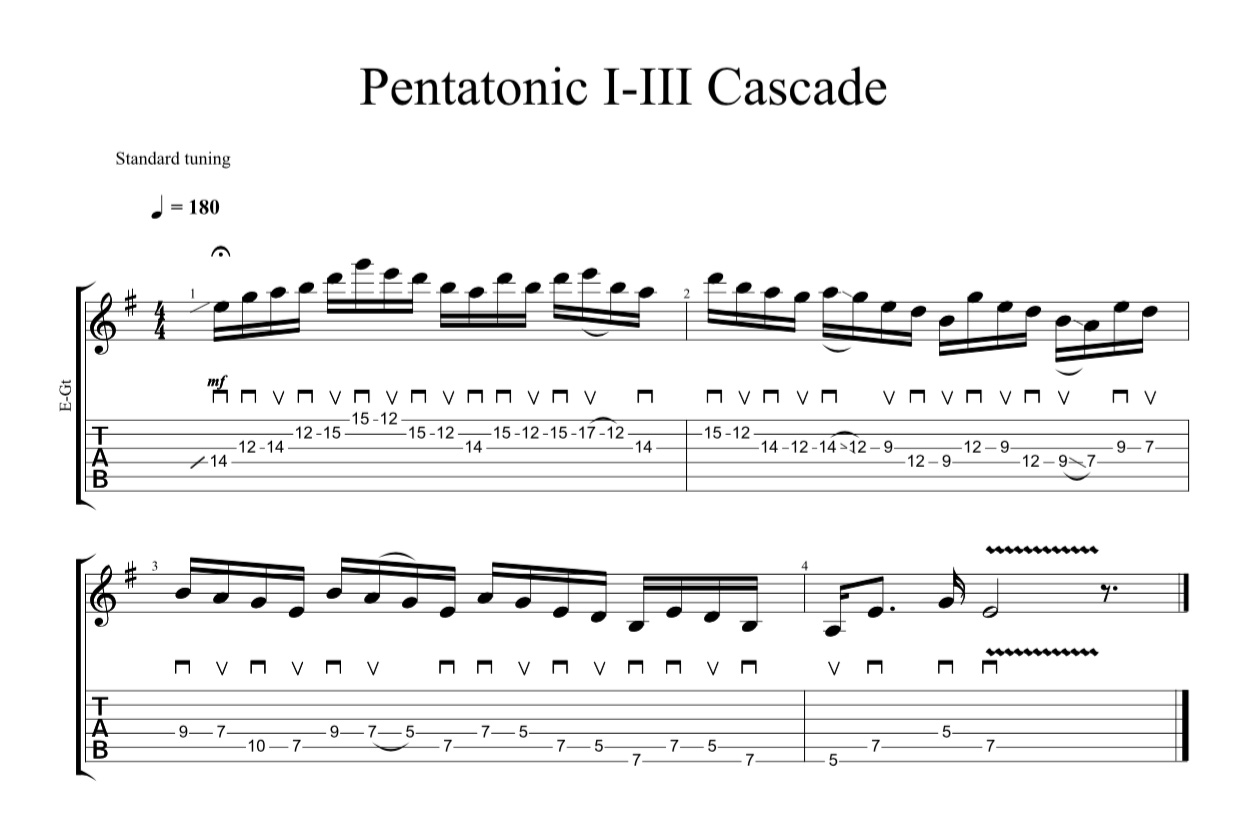
The cascading waterfall of sound that is Eric Johnson’s lead playing has captivated players and listeners for thirty years.
Sonically, it’s an almost formless wash of sunshine. In Eric’s ethereal soundscape, all the edges are smoothed away.
Even the distinction between scales and arpeggios seems to blur. His patterns tumble imperceptibly through positions, like falling through clouds. And his limitless supply of sparsely voiced diatonic chord substitutions only enhances the vertigo. And it’s the seemingly imperturbable precision of Eric’s right hand that makes it all possible.
And now, armed with a modern understanding of picking mechanics, we can actually begin to understand and recreate Eric’s wondrous style.
The foundational skill of the Eric Johnson lead style is the ability to play two-note per string passages at high speed. And of course, the ideal mechanical system for playing this is downward pickslanting.
Getting Straight with the Slant
Wait a minute, downward what?
If you haven’t watched Season 2, Episode 1 of Cracking the Code, now might be a good time to do so! Because it turns out that the secret to Eric Johnson’s picking technique is precisely the same one that powers Yngwie’s legendary scalar accuracy. And it is both ingenious and easy to replicate.

By simply rotating the picking hand downward, toward the floor, both Eric and Yngwie create a subtle but powerful change in the pick’s travel.
In this position, called downward pickslanting, downstrokes tend to bury themselves between the strings. But upstrokes are where the magic happens: the pick breaks free of the surrounding strings, and pulls away from the guitar’s body. This makes the upstroke the ideal time to switch strings, because nothing can get in the way. The pick simply drops down on the next chosen string and continues playing.
The genius of this solution is that the upstroke itself becomes the string switching movement. There is no longer any need to jump from string to string, and this removes the primary source of sloppiness and mistakes that most players face. Once you remove the error-prone process of “stringhopping” from string to string, it becomes dramatically easier to play with great accuracy.
Note also that downward pickslanting is not the same as edge picking. That’s a completely different, and much more commonly discussed pick angle. And it solves a totally separate problem. Players use the edge of the pick to reduce the resistance of the picking motion against the strings. But pickslanting uses rotation of the hand and/or fingers to change the entire trajectory of the pick’s travel. The key is that these two happen simultaneously in Eric’s technique.
Ah Via Pentatonic

In retrospect, this all should have been obvious. Eric is a one-way pickslanter, and he maintains a pronounced downward pickslant at nearly all times. This pickslant is more aggressive than Yngwie’s, and it’s plainly visible even on standard definition footage like his 1990 Hot Licks instructional video, Total Electric Guitar. Here’s a screen cap of just how clear that is.
And this pickslant dovetails perfectly with the cornerstone of his lead playing: the pentatonic scale. Thanks to its two-note-per-string design, the pentatonic scale is actually perfectly efficient. By simply starting on a downstroke, and using downward pickslanting, the sequence changes strings cleanly after every upstroke:

As you can see clearly here in this closeup footage, captured with our prototype iPhone slow-motion analysis rig, the smoothness and accuracy of the string switching is readily apparent. There is no jumping from string to string whatsoever.
Thanks to downward pickslanting, each upstroke is the string change. And this is true whether you’re ascending or descending. The mechanics don’t change based on the direction of the lick — once the upstroke is in the air, it can drop down in any direction it chooses, either higher or lower.
Astute observers will also notice that when played descending, with a down-up sequence on each string, the pentatonic scale is an outside picking lick. When played ascending, that same down-up picking sequence becomes inside picking. Of course, it’s still the same picking sequence, and because of this, there is no mechanical difference in difficulty between them.
In other words, in a downward pickslanting world like Eric’s, inside and outside picking as concepts have little relevance to actual difficulty. The only thing that matters is making sure that every string change happens after an upstroke.
The Pentatonic Cascade
Now, when you combine the power of the downward pickslanting upstroke with a little sweeping, amazing things start to happen:

This is an example of Eric’s rich pentatonic vocabulary which I like to call the “cascade”, and you can watch both the original and my version in the video that opened this lesson. It combines the power of downward pickslanting with ascending sweeping to create the descending ripple of pentatonic sound that has become Eric’s trademark.
This particular cascade moves from the pentatonic box position down to the mid-neck third pentatonic position. Along the way we see a variety of Eric’s signature moves: the initial ascending pickup, a single-string legato turnaround, a battery of slides and pull-off position shifts, and more. It’s a vocabulary that is uniquely his, but also immensely powerful as a tool chest in creating your own pentatonic, downward pickslanting explorations.
You’ll note that every alternate picked string change in the lick is still an upstroke. But now, we’ve augmented the mechanical formula with sweeping for switching strings after downstrokes. This is the same formula Yngwie uses, and the results are truly stunning.
To learn more about Eric’s picking mechanics, check out the Cracking the Code episode “Eric the Right“. Grab the Season Pass, and you can download a detailed pack of 30+ slow-motion clips and extensive written analysis.
If you really want to dig deep into EJ’s technique, take a look at the Masters in Mechanics “Cascade” Seminar — a massive 6+ hour investigation of Eric’s ethereal guitar genius that unlocks the magic of his downward pickslanting system.
We’ll leave you with a sample of some of the amazing and timeless sounds in Eric’s larger repertoire. All of these can be created by following the simple rules we’ve outline here. Ah Via Pentatonic, indeed!